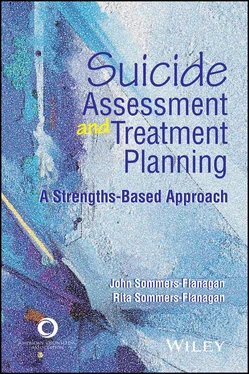John Sommers-Flanagan - Suicide Assessment and Treatment Planning
Здесь есть возможность читать онлайн «John Sommers-Flanagan - Suicide Assessment and Treatment Planning» — ознакомительный отрывок электронной книги совершенно бесплатно, а после прочтения отрывка купить полную версию. В некоторых случаях можно слушать аудио, скачать через торрент в формате fb2 и присутствует краткое содержание. Жанр: unrecognised, на английском языке. Описание произведения, (предисловие) а так же отзывы посетителей доступны на портале библиотеки ЛибКат.
- Название:Suicide Assessment and Treatment Planning
- Автор:
- Жанр:
- Год:неизвестен
- ISBN:нет данных
- Рейтинг книги:4 / 5. Голосов: 1
-
Избранное:Добавить в избранное
- Отзывы:
-
Ваша оценка:
- 80
- 1
- 2
- 3
- 4
- 5
Suicide Assessment and Treatment Planning: краткое содержание, описание и аннотация
Предлагаем к чтению аннотацию, описание, краткое содержание или предисловие (зависит от того, что написал сам автор книги «Suicide Assessment and Treatment Planning»). Если вы не нашли необходимую информацию о книге — напишите в комментариях, мы постараемся отыскать её.
Suicide Assessment and Treatment Planning — читать онлайн ознакомительный отрывок
Ниже представлен текст книги, разбитый по страницам. Система сохранения места последней прочитанной страницы, позволяет с удобством читать онлайн бесплатно книгу «Suicide Assessment and Treatment Planning», без необходимости каждый раз заново искать на чём Вы остановились. Поставьте закладку, и сможете в любой момент перейти на страницу, на которой закончили чтение.
Интервал:
Закладка:
Practice What You Preach
Many school and mental health professionals benefit from obtaining their own personal counseling or therapy. We recall listening with great interest to a famous behavior therapist speak of his preference for the emotional focus of gestalt therapy. He used behavioral approaches in his own clinical practice, but when he went for personal therapy, he chose experientially oriented counselors and psychotherapists who helped him explore deep emotions in the here and now. We hope that like this unusual behavior therapist who liked gestalt therapy, you will be open to pursuing whatever form of counseling you believe might be helpful to you and your situation.
Counselors and other helping professionals are consistently exposed to interpersonal and emotional stressors. In addition, perhaps more than ever, emotional stability is constantly affected by the global pandemic, social distancing, disrupted social networks (including networks of family and counseling peers), heightened awareness of racial and social injustice, sociopolitical upheaval, and other sources of uncertainty. To cope with common and uncommon stressors of professional counseling, you should consider whether you might benefit from engaging in personal counseling, creating peer support groups, or obtaining supervision. If you are working regularly with clients who are suicidal, your need for counseling support is magnified.
Examining and Bracketing Attitudes and Beliefs
Ethical counselors cannot allow personal values and attitudes to interfere with the provision of professional services (American Counseling Association, 2014; Corey, 2020). For example, let us say you believe that death by suicide is a mortal sin. You may feel pressured to push clients to banish their sinful suicidal thoughts. Although in most cases, counselors are ethically mandated to help prevent suicide, suicide researchers emphasize that competent suicide assessment and interventions begin with the acceptance of suicidal impulses. If you advocate too hard and too soon against suicide, you may activate client resistance (Brehm & Brehm, 1981; J. Sommers-Flanagan & Shaw, 2017). Instead of saving lives, you may end up alienating clients, thus putting them at greater risk.
The opposite extreme can occur when professionals believe fervently in the right to die by suicide. This belief can be communicated in destructive ways. For example, if your client leaves the session thinking, “My counselor seems to be an advocate for suicide” or “I didn’t get the sense that my counselor wants me to live,” then you have done your client a disservice and probably engaged in malpractice.
If your personal, religious, or philosophical beliefs about suicide interfere with your ability to provide competent and nonjudgmental assessment services, develop a therapeutic relationship, establish a collaborative treatment plan, or provide ongoing management of suicidal behaviors and implement research-supported interventions, then you are engaging in unprofessional and unethical practice. Professionals must be cognizant of their sometimes less than helpful attitudes and beliefs about suicide. Awareness allows professionals to ethically bracket attitudes, beliefs, and biases that could potentially interfere with competent care.
What Is Ethical Bracketing?
Ethical bracketing is defined as “the intentional separating” or “setting aside” of personal values to “provide ethical . . . counseling to all clients” (Kocet & Herlihy, 2014, p. 182). Ethical bracketing requires that counseling practitioners honor their commitment to working in the best interests of their clients—even when doing so conflicts with their religious values or beliefs.
Staying Focused When Strong Emotions Rise Up
As a Catholic, Mateo had deep moral values and an especially strong belief that suicide was morally wrong. As a graduate student in counseling, Mateo was learning about the need to bracket his values and not impose them on his clients. In his second year of training, Mateo worked with two clients who talked a lot about suicide. Whenever the word suicide came up in counseling, Mateo felt himself flinch inside. He had an impulse to plead with these clients to focus on God’s love as a solution to their suicidal crises. Mateo began questioning whether he could contain his moral judgments about suicide; he also began questioning whether he could continue in his training to become a professional counselor.
Mateo decided to discuss the feelings he was having with his supervisor. Mateo’s supervisor listened and helped Mateo explore his feelings. Later they brainstormed and problem-solved different ways Mateo could become better at monitoring and bracketing his moral judgments. In the end, Mateo and his supervisor identified four self-statements Mateo could use to compartmentalize or bracket his moral reactions:
1 “I know the research and clinical guidelines say that I can more effectively prevent suicide if I accept my clients’ suicidal ideation and remain nonjudgmental” (Jobes, 2016).
2 “I know that people who are feeling suicidal are already feeling shame; therefore, if I shame them in any way, I could increase their misery or sense of powerlessness.”
3 “I want to prevent suicide for religious and professional reasons. My best chance at preventing suicide involves using evidence-based assessment and treatment strategies.”
4 “When I feel triggered and judgmental, I will refocus my efforts on using nondirective paraphrases, reflections of feeling, open questions, and other motivational interviewing skills” (W. R. Miller & Rollnick, 2013).
Kocet and Herlihy (2014) offered a five-step counselor values-based conflict model to aid students and clinicians in ethical bracketing. Using Mateo’s situation as an example, we walk you through the steps of the model.
1 Determine the nature of values-based conflict. Mateo’s conflict was both personal and professional. Mateo believed that suicide was a sin, but he also knew that suicide competencies required him to listen nonjudgmentally as his clients talked about suicide.
2 Explore core issues and potential barriers to providing an appropriate standard of care. When his clients talked about suicide, Mateo was emotionally activated and felt impulses to confront clients with statements like “God loves you” and “Suicide is immoral” and “If you kill yourself, you’ll end up in hell.” These moralizing thoughts interfered with Mateo’s ability to have empathy for his clients.
3 Seek assistance/remediation for providing an appropriate standard of care. Mateo recognized his personal/professional conflict. He chose to meet with a supervisor he trusted to discuss the issues.
4 Determine and evaluate possible courses of action. Mateo and his supervisor agreed that Mateo could not avoid working with suicidality in counseling. They worked together to provide Mateo with a good rationale for using evidence-based (rather than religious-based) strategies for working with his clients. In addition, they identified internal cues that Mateo could use to alert himself to shift to using nondirective motivational interviewing skills.
5 Ensure that proposed actions promote client welfare. Mateo and his supervisor agreed to collaboratively and continuously monitor Mateo’s values-based judgments and behaviors during counseling sessions.
As illustrated in Mateo’s situation, personal values and attitudes have a complex and interactive relationship with self-care and ethical behaviors. Ethical bracketing is an important process for helping you juggle your values, attitudes, reactions, self-care, and ethical responsibilities. We return to ethical issues and counselor competence in Chapter 2and beyond. For now, we turn to our strengths-based model for understanding and working with people who are suicidal.
Читать дальшеИнтервал:
Закладка:
Похожие книги на «Suicide Assessment and Treatment Planning»
Представляем Вашему вниманию похожие книги на «Suicide Assessment and Treatment Planning» списком для выбора. Мы отобрали схожую по названию и смыслу литературу в надежде предоставить читателям больше вариантов отыскать новые, интересные, ещё непрочитанные произведения.
Обсуждение, отзывы о книге «Suicide Assessment and Treatment Planning» и просто собственные мнения читателей. Оставьте ваши комментарии, напишите, что Вы думаете о произведении, его смысле или главных героях. Укажите что конкретно понравилось, а что нет, и почему Вы так считаете.











